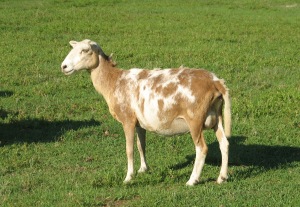Here at our ranch we have found Katahdin hair sheep to fit many of our needs, which makes them functional and purposeful. We have found them easy to maintain with very friendly demeanors. This is important to our needs because the sheep play very important roles in large annual live nativity scenes as well as participating in the petting areas for our annual Farm Day celebration!
Although we do not eat sheep meat on a regular basis, there is a very good market for their meat which makes them attractive to customers. Whether you are looking for colorful friendly pasture pets, or a healthy meal Katahdin hair sheep deserve your consideration. If you have any questions or concerns please feel free to contact us. Please see Katahdin breed characteristics below for more in depth description of Katahdin hair sheep.
Breed Characteristics
Katahdins are hardy, adaptable, low maintenance sheep that produce superior lamb crops and lean, meaty carcasses. They do not produce a fleece and therefore do not require shearing. They are medium sized and efficient, bred for utility and for production in a variety of management systems. Ewes have exceptional mothering ability and lamb easily; lambs are born vigorous and alert. The breed is ideal for pasture lambing and grass/forage-based management systems.
Adaptability: Katahdins have demonstrated wide adaptability. They were derived from breeds that originated in the Caribbean and British Islands, and the state of Maine was their original home. In cold weather, they grow a very thick winter coat which then sheds during warm seasons. Their smooth hair coat and other adaptive characteristics allow them to tolerate heat and humidity well. Katahdins are also significantly more tolerant of internal and external parasites than wooled sheep, and if managed carefully require only minimal parasite treatment.
Temperament: Katahdins are docile so are easily handled. They exhibit moderate flocking instinct.
Size: Live weight of a mature ewe in good condition usually ranges from 125 to 185 pounds; a mature ram will weigh 180 to 250 pounds. Average birth weight of twins is about 8 pounds.
Reproduction: Ewes and rams exhibit early puberty and generally have a long productive life. Mature ewes usually have twins, occasionally producing triplets or quadruplets. A well-managed and selected flock should produce a 200% lamb crop. Rams are aggressive breeders, generally fertile year round, and can settle a large number of ewes in the first cycle of exposure. With selection a flock can consistently lamb throughout the year.
Mothering: The Katahdin ewe shows a strong, protective mothering instinct, usually lambs without assistance, and has ample milk for her lambs. Rejection of lambs is rare.
Carcass and Growth: Lambs produce a high quality, well-muscled carcass that is naturally lean and consistently offers a very mild flavor. Lambs are comparable to other medium-sized maternal breeds in growth and cutability. Lambs are desirable for specialty markets at a variety of ages and weights; wethers are appropriate for conventional North American markets at 95 to 115 pounds.
Coat: The hair coat of the Katahdin varies in length and texture among individuals and can be any color or color combination. It generally consists of coarse outer hair fibers and an undercoat of fine wooly fibers that becomes very thick and longer if cold weather sets in and day length decreases. This undercoat and some hair naturally sheds as temperature and day length increase seasonally, leaving a shorter, smooth summer coat. While some uses may be found for the shed fiber, it is generally not harvested.
Crossbreeding: The Katahdin can be used in crossbreeding programs. When crossed with wool sheep, the first generation offspring will in most cases have wool fleeces with hair interspersed (the wool from such crosses should be segregated to avoid contaminating higher quality wools). It usually takes at least 3 generations, depending on the type of wool sheep parentage, to obtain offspring with a shedding hair coat and other purebred characteristics. Katahdin ewes are well-suited as a base in a terminal sire crossbreeding program to produce market lambs.
Market: Katahdins are in demand by:
those who want to raise sheep that do not need shearing
producers who live in areas where wool is a detriment to adaptation or where wool markets are poor
those who wish to eat or market superior quality lamb with a mild flavor
stock dog trainers
land managers looking for a low-maintenance small ruminant
(Breed characteristics reprinted from Katahdin Hair Sheep International)

